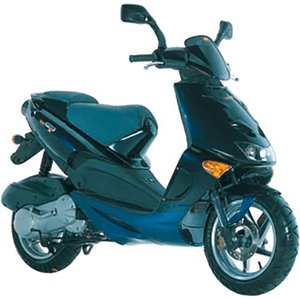Aprilia SR 150 (1999-2000) Review: A Blast from the Two-Stroke Past
Introduction
The Aprilia SR 150, produced between 1999 and 2000, remains a cult favorite among scooter enthusiasts who crave the raw, unfiltered energy of a two-stroke engine. This Italian-designed machine blends practicality with a sporty edge, offering a riding experience that’s equal parts nostalgic thrill and urban convenience. While modern scooters prioritize refinement, the SR 150 wears its gritty character like a badge of honor. Let’s dive into what makes this compact dynamo memorable.
Design & Styling: Aggressive Lines Meet Functional Simplicity
The SR 150 breaks away from the boxy silhouettes of ’90s commuter scooters with its angular fairings, sharp headlights, and a stepped seat that hints at sportbike DNA. The 837 mm (33 inches) seat height accommodates riders of most statures, while the 107 kg (236 lbs) curb weight keeps it nimble for city traffic. Aprilia’s use of bold color schemes—think fiery reds and electric blues—gave it a rebellious flair that still turns heads today.
The minimalist dashboard features an analog speedometer and basic warning lights, staying true to its no-frills ethos. Storage is limited to a small under-seat compartment, but the open floorboard offers room for groceries or a backpack. Build quality feels robust, though some plastic panels can creak over time—a small price for its spirited personality.
Riding Experience: Two-Stroke Thunder in a Small Package
Fire up the 150cc single-cylinder two-stroke, and the raspy exhaust note immediately signals this isn’t your average commuter. The engine idles at 1,500 ± 100 RPM, settling into a rhythmic vibration that courses through the handlebars. Twist the throttle, and the SR 150 leaps forward with urgency, its powerband hitting hard around 5,000 RPM. Acceleration feels brisk for its class, pushing you back into the seat as the CVT transmission (Keilriemen-Automatik) seamlessly transfers power to the rear wheel.
Top speed hovers around 90 km/h (56 mph), but the real joy lies in its mid-range punch. Darting through traffic is effortless, aided by the lightweight chassis and responsive steering. The suspension setup—basic telescopic forks up front and dual shock absorbers at the rear—handles bumps adequately, though sharp potholes can jolt the rider. Braking relies on a single disc upfront and a drum at the rear, with DOT 4 fluid ensuring decent bite. It’s no corner-carver, but the SR 150 feels planted enough for spirited urban rides.
Engine & Performance: The Heart of the Beast
The liquid-cooled two-stroke engine is the star here. Unlike modern four-strokes, it thrives on simplicity: no valves, no timing belts—just a piston, spark plug (NGK BR9ES or BR9EIX), and a hunger for two-stroke oil. Mixing oil with fuel is mandatory, creating a smoky exhaust aroma that purists adore. Maintenance is straightforward, but neglect the 2-Taktöl, and engine seizures become a real risk.
Cooling is handled by a forced-air system (Gebläsegekühlt), which keeps temperatures in check during stop-and-go traffic. The recommended spark plug gap of 0.6 mm ensures consistent ignition, while the SAE 5W-20 fork oil in the front suspension balances comfort and stability. Fuel efficiency? Don’t expect miracles—this scooter prioritizes fun over frugality.
Competition: How Does the SR 150 Stack Up?
In the late ’90s, the SR 150 faced fierce rivals:
- Yamaha Aerox 100: A lighter, less powerful two-stroke with superior fuel economy but lacking the SR 150’s aggressive styling.
- Honda Dio AF-18: A four-stroke workhorse known for reliability but duller performance.
- Peugeot Speedfight 100: French flair with similar two-stroke verve, though smaller displacement.
The Aprilia’s edge lies in its larger 150cc engine and sportier ergonomics. While the Honda and Yamaha appealed to practicality seekers, the SR 150 catered to riders craving excitement. However, its thirst for oil and fuel made it costlier to run long-term compared to four-stroke rivals.
Maintenance: Keeping the Two-Stroke Alive
Owning an SR 150 requires dedication to its two-stroke heartbeat. Here’s what to prioritize:
- Oil Mixing: Use high-quality 2-Taktöl at the correct ratio. Cheap oils can clog the exhaust or damage the piston.
- Spark Plugs: Swap the NGK BR9ES or BR9EIX every 3,000 km (1,864 miles). Check the 0.6 mm gap regularly.
- CVT Belt: Inspect the Keilriemen every 10,000 km (6,214 miles) for wear. A slipping belt kills acceleration.
- Tire Pressure: Maintain 1.9 bar (28 psi) front and 2.1 bar (30 psi) rear for optimal grip and fuel efficiency.
- Final Drive Oil: The 75W-90 gear oil needs changing every 5,000 km (3,107 miles).
Pro Tip: Clean the carburetor annually to prevent varnish buildup—a common issue in seldom-used two-strokes.
Conclusion: A Love Letter to Simplicity
The Aprilia SR 150 isn’t just a scooter; it’s a time capsule from an era when riding was visceral and unfiltered. Its two-stroke engine demands attention, rewarding those who embrace its quirks with thrilling performance. While modern alternatives offer polish, the SR 150 remains a icon for riders who value character over convenience.
At MOTOPARTS.store, we keep the legacy alive with OEM-spec parts—from NGK spark plugs to CVT belts—ensuring your SR 150 continues to scream through city streets. After all, why ride ordinary when you can ride extraordinary?



















